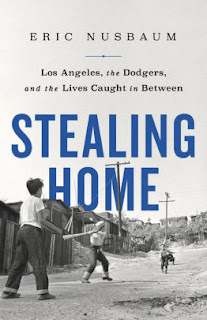 In the Company of Crows and Ravens; Dog Days, Raven Nights; and Welcome to Subirdia.
In the Company of Crows and Ravens; Dog Days, Raven Nights; and Welcome to Subirdia.Marzluff applied the “Page 99 Test” to his new book, In Search of Meadowlarks: Birds, Farms, and Food in Harmony with the Land, and reported the following:
On page 99 of In Search of Meadowlarks I discuss how nesting success of birds varied among agricultural and reserved areas on a small organic farm in western Washington. These observations come from a study conducted by my colleagues and myself in which we found quite high nesting success by birds in both forest reserves and agricultural field borders. We found no nests within the active agricultural fields themselves. I went on to describe some of the birds we found nesting, which were mostly also those that inhabit nearby suburbs. However, the farm provided habitats for some different birds than did the suburbs, namely Rufous rather than Anna’s Hummingbirds, Tree rather than Violet-green Swallows, and a bird new to my study, the Common Yellowthroat. I used the remainder of page 99 to introduce the reader to the Yellowthroat, a migratory warbler, that becomes an important player throughout the remainder of the chapter.Learn more about In Search of Meadowlarks at the Yale University Press website.
One gets a poor idea of the whole book by reading page 99. While we learn a bit about how birds fare in agricultural settings on page 99, we learn nothing about what farmers can and are doing to make their farms more appealing to birds. We learn only about one farm on page 99 and nothing about the wide diversity of farms—each with particular issues and problems that are solved—I report from throughout the entire book. Nothing is learned about Costa Rica, Montana, Nebraska, or California on page 99. No knowledge is gained concerning the responses of birds and other wildlife to ranching, raising grain, or viticulture. Missing from page 99 are interesting discussions about how barn owls, bluebirds, and sparrows help farmers control pests on their crops. Also not mentioned on page 99 is a consideration of whether it is better for nature to reserve natural lands and intensively farm other lands or crop more land in a wildlife-friendly manner. The history of farming and its occurrence outside of human society is missing from page 99, yet provides an important introduction to the book. The evolutionary responses of organisms—weeds, viruses, domestic species, birds, and people to agriculture puts my book into broader context, but again this discussion is missing from page 99. Finally, the important discussion concerning how as a society we will meet the food needs of a growing and increasingly affluent human population while also conserving some of the natural habitats that other species require is completely absent from page 99. This discussion leads to the conclusion of the book wherein I emphasize the actions that we all—farmers, consumers, restaurateurs, and others—can do to assure future food security and a vibrant natural world.
I always enjoy assessing my books from page 99. I find it interesting that my reading of page 99 provides detailed and general information that might pique a reader’s interest in the rest of my story. As we learn about one type of bird, we might begin to wonder about other species and how they respond to agriculture. As we read about reproduction on one farm, perhaps we become curious about other aspects of a bird’s life, such as lifespan or migration. I discuss these aspects of bird life in other parts of the book. Lastly, I hope readers of page 99 will wonder what they can do to keep Common Yellowthroats common on farms. By continuing to read my book these questions are answered, quenching the thirst for more information that page 99 instills.
See: Coffee with a Canine: Colleen and John Marzluff & Reese, Digit and Bellatrix.
The Page 99 Test: Dog Days, Raven Nights.
The Page 99 Test: In the Company of Crows and Ravens.
The Page 99 Test: Gifts of the Crow.
--Marshal Zeringue

























